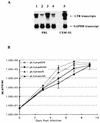Comparative analyses of intracellularly expressed antisense RNAs as inhibitors of human immunodeficiency virus type 1 replication
- PMID: 9499041
- PMCID: PMC109480
- DOI: 10.1128/JVI.72.3.1894-1901.1998
Comparative analyses of intracellularly expressed antisense RNAs as inhibitors of human immunodeficiency virus type 1 replication
Abstract
The antiviral activities of intracellularly expressed antisense RNAs complementary to the human immunodeficiency virus type 1 (HIV-1) pol, vif, and env genes and the 3' long terminal repeat (LTR) sequence were evaluated in this comparative study. Retroviral vectors expressing the antisense RNAs as part of the Moloney murine leukemia virus LTR promoter-directed retroviral transcript were constructed. The CD4+ T-cell line CEM-SS was transduced with retroviral constructs, and Northern blot analyses showed high steady-state antisense RNA expression levels. The most efficient inhibition of HIV-1 replication was observed with the env antisense RNA, followed by the pol complementary sequence, leading to 2- to 3-log10 reductions in p24 antigen production even at high inoculation doses (4 x 10(4) 50% tissue culture infective doses) of the HIV-1 strain HXB3. The strong antiviral effect correlated with a reduction of HIV-1 steady-state RNA levels, and with intracellular Tat protein production, suggesting that antisense transcripts act at an early step of HIV-1 replication. A lower steady-state antisense RNA level was detected in transduced primary CD4+ lymphocytes than in CEM-SS cells. Nevertheless, replication of the HIV-1 JR-CSF isolate was reduced with both the pol and env antisense RNA. Intracellularly expressed antisense sequences demonstrated more pronounced antiviral efficacy than the transdominant RevM10 protein, making these antisense RNAs a promising gene therapy strategy for HIV-1.
Figures








Similar articles
-
Molecular strategies to inhibit HIV-1 replication.Retrovirology. 2005 Feb 16;2:10. doi: 10.1186/1742-4690-2-10. Retrovirology. 2005. PMID: 15715913 Free PMC article. Review.
-
Intracellular expression of RNA transcripts complementary to the human immunodeficiency virus type 1 gag gene inhibits viral replication in human CD4+ lymphocytes.J Virol. 1996 Dec;70(12):8792-800. doi: 10.1128/JVI.70.12.8792-8800.1996. J Virol. 1996. PMID: 8971008 Free PMC article.
-
Inhibition of human immunodeficiency virus type-1 by retroviral vectors expressing antisense-TAR.Hum Gene Ther. 1994 Dec;5(12):1467-75. doi: 10.1089/hum.1994.5.12-1467. Hum Gene Ther. 1994. PMID: 7711139
-
A combination anti-HIV-1 gene therapy approach using a single transcription unit that expresses antisense, decoy, and sense RNAs, and trans-dominant negative mutant Gag and Env proteins.Front Biosci. 2002 Feb 1;7:a15-28. doi: 10.2741/ding. Front Biosci. 2002. PMID: 11815282
-
Antisense RNA gene therapy for studying and modulating biological processes.Cell Mol Life Sci. 1999 Mar;55(3):334-58. doi: 10.1007/s000180050296. Cell Mol Life Sci. 1999. PMID: 10228554 Free PMC article. Review.
Cited by
-
Engineering T Cells to Functionally Cure HIV-1 Infection.Mol Ther. 2015 Jul;23(7):1149-1159. doi: 10.1038/mt.2015.70. Epub 2015 Apr 21. Mol Ther. 2015. PMID: 25896251 Free PMC article. Review.
-
Genetic therapies against HIV.Nat Biotechnol. 2007 Dec;25(12):1444-54. doi: 10.1038/nbt1367. Nat Biotechnol. 2007. PMID: 18066041 Free PMC article. Review.
-
Molecular strategies to inhibit HIV-1 replication.Retrovirology. 2005 Feb 16;2:10. doi: 10.1186/1742-4690-2-10. Retrovirology. 2005. PMID: 15715913 Free PMC article. Review.
-
Antisense-mediated inhibition of human immunodeficiency virus (HIV) replication by use of an HIV type 1-based vector results in severely attenuated mutants incapable of developing resistance.J Virol. 2004 Jul;78(13):7079-88. doi: 10.1128/JVI.78.13.7079-7088.2004. J Virol. 2004. PMID: 15194784 Free PMC article.
-
Prevention of HIV-1 infection in human peripheral blood mononuclear cells by specific RNA interference.Nucleic Acids Res. 2002 Nov 15;30(22):4830-5. doi: 10.1093/nar/gkf627. Nucleic Acids Res. 2002. PMID: 12433985 Free PMC article.
References
Publication types
MeSH terms
Substances
LinkOut - more resources
Full Text Sources
Other Literature Sources
Medical
Research Materials

